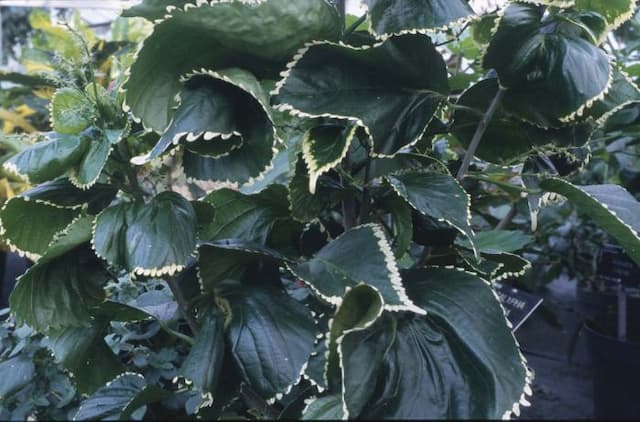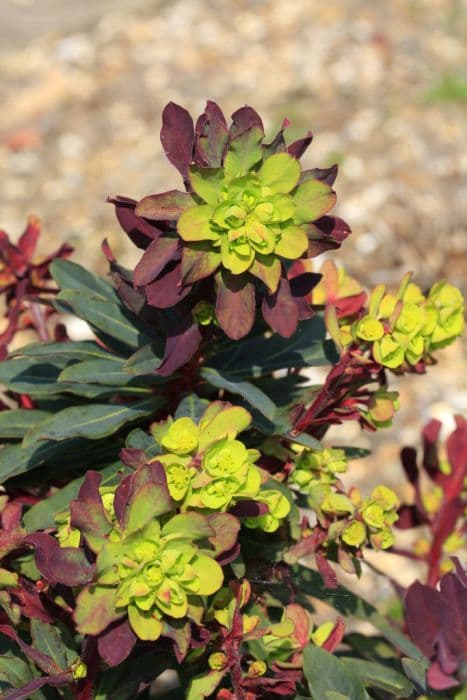Marsh spurge Euphorbia palustris

ABOUT
The plant known as marsh spurge is characterized by its attractive green foliage and distinctive flower displays. The leaves of this plant are typically narrow and oblong with a slightly pointed tip, featuring a bright green color which may turn to striking shades of red or orange during the fall. It produces small, inconspicuous flowers that are typically surrounded by large, showy, yellowish-green bracts that greatly resemble petals. These floral bracts are quite eye-catching and give the plant a significant ornamental value. The flowers are clustered together in what is termed as an inflorescence, and each individual cluster presents a dome-like shape that is both unusual and attractive. Marsh spurge also produces a milky white sap that is visible when any part of the plant is broken or cut.
About this plant
 Names
NamesFamily
Euphorbiaceae
Synonyms
Marsh Spurge, Swamp Spurge, Marsh Euphorbia
Common names
Tithymalus palustris, Esula palustris
 Toxicity
ToxicityTo humans
Marsh spurge (Euphorbia palustris) contains a toxic white latex sap that can cause skin irritation upon contact. If ingested, the sap can irritate the mouth, throat, and stomach, leading to symptoms such as nausea, vomiting, and diarrhea. In severe cases, ingestion may also cause swelling of the throat, difficulty breathing, and it can even be life-threatening. Therefore, it is crucial to avoid consuming any part of this plant and to wash hands thoroughly after handling.
To pets
Marsh spurge (Euphorbia palustris) is also toxic to pets due to its milky sap containing irritants and toxins. If ingested by pets, it can cause similar symptoms as in humans, including vomiting, diarrhea, and excessive drooling. In severe cases, pets may experience difficulty breathing, weakness, and lethargy. If a pet comes into contact with the sap, it may also cause skin and eye irritation. Immediate veterinary attention should be sought if a pet is suspected of ingesting any part of the plant.
 Characteristics
CharacteristicsLife cycle
Perennials
Foliage type
Deciduous
Color of leaves
Green
Flower color
Yellow
Height
2-3 feet (60-90 cm)
Spread
2 feet (60 cm)
Plant type
Herb
Hardiness zones
4
Native area
Europe
Benefits
 General Benefits
General Benefits- Attracts Pollinators: Euphorbia palustris is known to attract beneficial pollinators such as bees and butterflies, which help in the pollination of plants and the overall health of the garden.
- Ornamental Value: With its striking greenish-yellow flower heads and attractive foliage, Marsh Spurge adds aesthetic value to gardens and landscapes.
- Drought Tolerance: Once established, Marsh Spurge can tolerate periods of drought, making it a suitable choice for xeriscaping and water-wise gardens.
- Adaptable Growth: It can thrive in a variety of soil types, although it prefers wet conditions, making it versatile for different garden scenarios.
- Seasonal Interest: Euphorbia palustris provides seasonal interest with its changing foliage color in the fall and persistent structure during the winter months.
- Low Maintenance: It generally requires minimal care once established, making it a convenient option for gardeners with limited time.
- Erosion Control: With its ability to grow in wet conditions, Marsh Spurge can help stabilize soil and prevent erosion in certain landscapes.
- Habitat Support: As a native plant in some areas, Euphorbia palustris can provide habitat and food for local wildlife, contributing to the ecosystem’s diversity.
 Medical Properties
Medical PropertiesThis plant is not used for medical purposes.
 Air-purifying Qualities
Air-purifying QualitiesThis plant is not specifically known for air purifying qualities.
 Other Uses
Other Uses- Euphorbia palustris can be used in natural dyeing processes, its tissues containing compounds that can be developed into various colorants for fabrics.
- The milky sap found within the stems of Marsh Spurge is sometimes explored in experimental adhesives due to its sticky nature, though one should be cautious since it can be an irritant.
- Some artists use the sap of Marsh Spurge to create natural paints and pigments, although this is a less conventional approach to art materials.
- In landscape design, Marsh Spurge can be used to stabilize soil and prevent erosion in wet areas due to its hardy root system.
- Marsh Spurge is utilized as a companion plant in gardens, reputed to repel certain pests due to its toxic sap.
- Because of its distinctive form and color, Marsh Spurge is often used in floral arrangements and as a striking centerpiece in garden design.
- Hobbyists in the field of model-making sometimes use dried parts of Marsh Spurge as a natural material for creating miniature trees and shrubs.
- In permaculture, Marsh Spurge can function as a part of plant guilds that focus on wetland areas, supporting biodiversity and ecological balance.
- The plant has potential use in phytoremediation to clean up soils contaminated with certain toxins although this should be carefully managed due to its invasive nature.
- Marsh Spurge, with its attractive seed pods, is sometimes used in dried flower crafts and decorations due to their long-lasting and interesting texture.
Interesting Facts
 Feng Shui
Feng ShuiThe Marsh Spurge is not used in Feng Shui practice.
 Zodiac Sign Compitability
Zodiac Sign CompitabilityThe Marsh Spurge is not used in astrology practice.
 Plant Symbolism
Plant Symbolism- Persistence: Euphorbia palustris, commonly known as Marsh Spurge, often thrives in wetland areas, symbolizing the ability to persist and adapt to challenging environments.
- Caution: The sap of Marsh Spurge can be irritating to the skin and toxic if ingested, making it a symbol for caution and the necessity of being wary and observant.
- Transformative Power: This plant can transform a landscape with its vibrant green foliage and yellow-green flowers, symbolizing change and the power of nature to revitalize.
- Healing: Historically, Euphorbias have been used in traditional medicine, and thus Marsh Spurge can symbolize healing despite its toxic properties when not used correctly.
 Water
WaterThe Marsh Spurge prefers moist soil and should be watered regularly to maintain its moisture level, especially during dry spells. On average, watering once a week with 1 to 1.5 gallons should suffice. However, during the peak of summer or in particularly dry climates, the frequency may increase to twice a week. Ensure that the water penetrates deeply into the soil to encourage strong root growth. Over-watering should be avoided, as it can lead to root rot, so always check the soil moisture level before adding more water.
 Light
LightThe Marsh Spurge thrives in full sun to partial shade. The ideal location would offer bright, indirect light as intense direct sunlight can sometimes scorch the leaves. If planted outdoors, a spot that receives sunlight for most of the day with some afternoon shade would be optimal. Indoors, a south or east-facing window where the plant can get at least a few hours of sunlight each day would be suitable.
 Temperature
TemperatureThe Marsh Spurge is hardy and can withstand temperatures as low as 10 degrees Fahrenheit but can only tolerate heat up to approximately 75 degrees Fahrenheit. Ideally, it prefers to be in a range where daytime temperatures are between 60 and 70 degrees Fahrenheit and nighttime temperatures do not drop below 50 degrees Fahrenheit. These conditions mimic its natural habitat, which leads to healthier growth.
 Pruning
PruningPruning the Marsh Spurge is essential to remove any spent flowers or damaged stems, which encourages new growth and maintains the plant's shape. Pruning should be done in late winter or early spring before new growth begins. Cut back the old stems to the ground to promote fresh growth. Wearing gloves is advisable, as the sap can be an irritant.
 Cleaning
CleaningAs needed
 Soil
SoilThe best soil mix for Marsh Spurge (Euphorbia palustris) should be well-draining with some organic matter, such as a blend of loam, peat, and sand, which helps retain moisture without becoming waterlogged. The ideal soil pH for Marsh Spurge is slightly acidic to neutral, ranging from 6.0 to 7.0.
 Repotting
RepottingMarsh Spurge typically does not need frequent repotting as it's a perennial that can spread in the garden. However, if grown in containers, consider repotting every 2 to 3 years to refresh the soil and give the roots more room to grow.
 Humidity & Misting
Humidity & MistingMarsh Spurge thrives in average humidity conditions found in most outdoor environments and does not demand high humidity, making it well-suited for typical garden settings without special humidity requirements.
 Suitable locations
Suitable locationsIndoor
Ensure bright light; well-draining soil mix.
Outdoor
Plant in sunny spot, well-draining soil.
Hardiness zone
4-9 USDA
 Life cycle
Life cycleThe life cycle of Euphorbia palustris, commonly known as marsh spurge, begins with seed germination in moist soil conditions, typically occurring in the spring. As the seedling emerges, it develops into a young plant with characteristic green foliage. Marsh spurge proceeds to a phase of vegetative growth during which it forms a robust stem and lance-shaped leaves, and it may spread through rhizomes, creating a dense clump. During late spring to early summer, the plant enters its reproductive stage, displaying clusters of small greenish-yellow flowers surrounded by showy yellow-green bracts that attract pollinators. After pollination, the plant produces seed capsules that eventually burst open to release seeds, which disperse to begin a new generation. Finally, in autumn, the aerial parts of marsh spurge die back to the ground, with the plant surviving the winter as dormant rootstock or as seeds in the soil.
 Propogation
PropogationPropogation time
Spring-Early Summer
Propogation: Marsh Spurge (Euphorbia palustris) is commonly propagated by seed or division. The most popular method is division, which is best done in early spring as the plant emerges from dormancy. To propagate Marsh Spurge by division, carefully dig up an established clump and gently separate the rootball into smaller sections, ensuring each new section has a portion of the root system and shoots. Replant these divisions promptly into well-preparing soil, spacing them about 15 to 18 inches (38 to 46 cm) apart to allow enough room for growth. Water the new divisions thoroughly after planting to help establish them. It is important to handle Euphorbia with care due to the milky sap, which can be irritating to the skin and eyes.



![Spurge [Blackbird]](/_next/image?url=https%3A%2F%2Fplants-admin.emdemapps.com%2Fimages%2Fplants%2F%2Fimages%2F604b535f37783.png&w=640&q=75)





